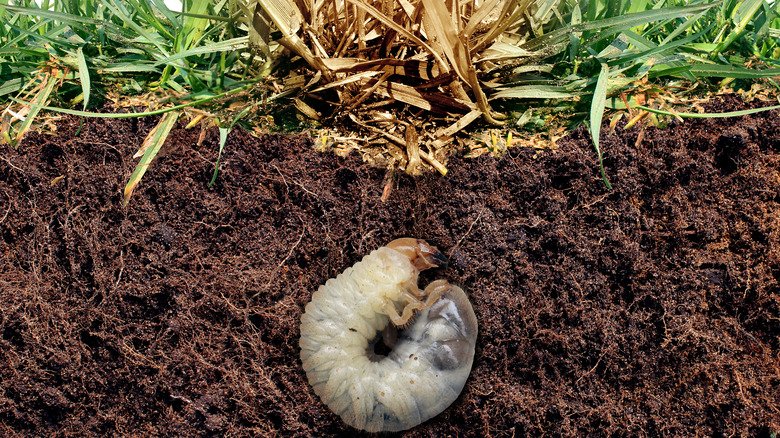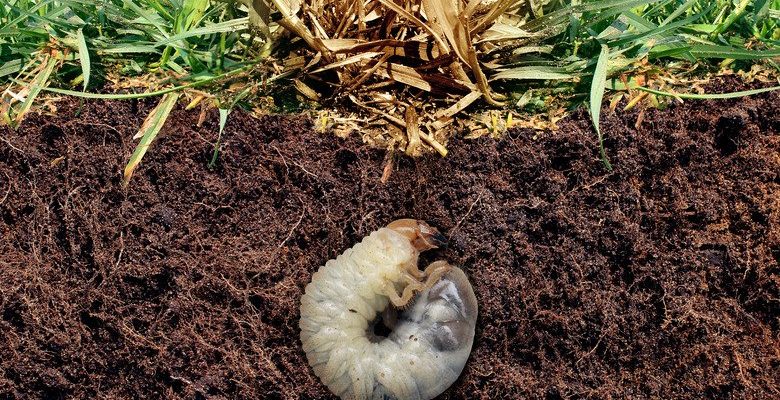
Grub worms, actually the larvae of various beetles, live in your soil, munching on roots and sometimes causing mayhem in gardens and lawns. But there’s a lot of confusion swirling around them. Are they truly the main reason for your grass’s decline? Or is something else at play? Just like with any garden challenge, it helps to know the facts before taking action. So, grab a cup of coffee, and let’s dig into the dirt on grub worms and the myths surrounding lawn browning.
What Are Grub Worms?
Grub worms are the larvae of beetles such as Japanese beetles and May/June beetles. When they hatch, they’re small, white, and C-shaped. They spend their days underground, munching on the roots of your grass and other plants. Think of them as little lawn gremlins that can wreak havoc if left unchecked.
These pests thrive in warm, moist soil and can be particularly troublesome in late summer and early fall when they’re most active. A heavy infestation can lead to significant lawn damage, turning your once-green turf into a sorry sight. However, detecting them isn’t always straightforward. Lawn browning can also be due to poor care, lack of water, or disease. So, it’s essential to identify the root cause (pun intended) before jumping to conclusions.
Myth 1: Grub Worms Are Always the Cause of Lawn Browning
It’s easy to point fingers at these little critters when you see your lawn fading to brown. However, it’s important to remember that grass can turn brown for many reasons. Just because you see some grub worms doesn’t mean they’re the sole reason for your lawn’s distress.
Here’s the thing: factors like drought, overwatering, nutrient deficiencies, or lawn diseases can all contribute to unhealthy grass. Grub worms may add to the problem, but they’re not the only culprit. That’s why a thorough inspection of your lawn is crucial.
Much like a doctor diagnosing a patient, you need to look at the whole picture. Besides checking for grubs, consider other elements, such as soil quality or watering practices, that could be affecting your lawn’s health.
Myth 2: All Grub Worms are Bad for Your Lawn
Not all grub worms are created equal. While some species can cause significant damage, others don’t pose much of a threat. For example, beneficial nematodes, which are sometimes confused with grub worms, help control harmful pest populations without harming your grass.
It’s a bit like comparing a house cat to a lion: both are felines, but one is a beloved pet, and the other could eat you for dinner! The same goes for grubs—some are harmless, while others can wreck your lawn.
To manage this, you can perform a simple test. Dig up a small section of your lawn and check for any grubs. If you find a few, they might not be causing any damage. However, if you see a high number, it’s time to take action. Knowing which species you’re dealing with is key to determining the best course for your lawn.
Myth 3: You Need to Spray Your Lawn with Chemicals Immediately
When folks discover a grub problem, their first instinct is often to grab the nearest pesticide. But let’s take a step back. Chemical treatments can be effective, but they’re not always necessary and can sometimes do more harm than good.
Consider this: always start with a natural approach. Introducing beneficial insects like birds or nematodes can help control grub populations without chemicals. Sometimes, simply improving your lawn care routine—like proper watering and aeration—can make a world of difference.
If you do choose to use pesticides, be sure to select a product that targets grubs specifically and is safe for your lawn and garden. And always follow the instructions closely to minimize any negative effects on the environment.
Myth 4: Grub Worms Can’t Be Prevented
Some might think once grubs invade, there’s no turning back. But in reality, prevention is quite possible! One of the best methods is maintaining a healthy lawn through regular care.
Here are some tips to keep grub worms at bay:
- Water Wisely: Deep and infrequent watering encourages deeper roots, making grass more resilient.
- Mow Regularly: Keeping your lawn at the right height helps promote grass health.
- Fertilize Appropriately: A balanced fertilizer can strengthen your grass and make it less appealing to pests.
- Rotate Treatments: If you must use pesticides, rotate them to prevent resistance.
Taking these steps can help create an environment where grub worms struggle to thrive. Just remember, healthy grass is your best defense!
Myth 5: Once Your Lawn is Brown, It Can’t Be Saved
If your lawn has already seen better days, all hope isn’t lost. Many people think that once grass turns brown, it’s game over. But don’t despair! There are ways to revive it.
First, assess the damage. If the grass is merely dormant due to heat or drought, it can bounce back with proper care. Make sure to water deeply and consistently during dry spells. On the flip side, if there’s significant root damage from grubs, you might need to reseed or patch certain areas.
Think of it like a hair makeover—a little care and the right treatment can bring back that lush, green glory. Restoration isn’t impossible; it just requires dedication and the right approach.
Understanding grub worms and their impact on lawn health is essential for keeping your yard looking vibrant. By recognizing that not all browning is due to these pests, and that many factors can contribute to lawn health, you’re already on the right track. Remember that prevention is much easier than treatment, so stay proactive in your lawn care routine.
Taking the time to learn about your lawn’s specific needs will help you distinguish between grubs and other potential issues. And, in the battle of your lawn versus grubs, knowledge is your best weapon. So, next time you see those little white worms squirming in your soil, you’ll know just how to respond—helping your lawn flourish once more!

